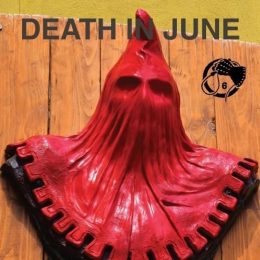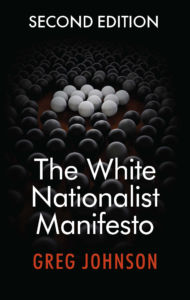1,519 words
Essence! is the most recent batch of material from Douglas Pearce’s Death in June, released on November 30, 2018. Essence! pulls from the earlier output of 90s Death in June, including its eclectic sampling work, noisy elements, and tastefully perverse whip-cracks for its compositions. Pearce brings the Death in June sound into the modern age, however
— his lyricism and avant-garde sonic hijinks proving old dogs can, indeed, learn new tricks. We get references to Euromaidan in Ukraine — though Pearce is no stranger to poetic rumination on revolution — and mentions of deep states and webs.
In all of its parts, Essence! makes for an album that defines Death in June in toto — or, its essence. Someone who is familiar with Pearce’s body of work, as varied and large as it is, will immediately notice this synthesis. It’s also refreshing to hear these sounds crisply recorded with modern techniques, lending Pearce’s atmospheric prowess a glow that escaped him in his earlier works. Lyrically, Pearce also moves even closer to the abstract and to the occult, dressing D-Day mythos with upturned doom and gloom to evoke the uncanny. Death in June after the early 2000s was often a wholly somber affair, its melancholy unambiguous. Essence! works in another direction, juxtaposing some of Pearce’s most flowery and melodic composition with the dreary cynicism one would expect from someone his age.
Interestingly enough, the cover of Essence! lacks a masked Pearce, as is typical of his releases post-2000. A rather intimidating crimson knight takes his place; masked too, nonetheless, a combination of Pearce’s old aesthetic touchstones and his new, experimental ethos. This confluence can be seen in much of the album’s music.
“Welcome to Country,” the opening track, would not be out of place on a blackgaze album or industrial release. It is buzzy, all-encompassing, and remarkably fresh sounding from Pearce, who has a tendency to neglect a doormat for his records. It ends with a sampled passage from the unsettling German film, Der Unhold:
That day I understood that fate was real
That she was cruel
And that she was on my side
I would be protected, saved, and guided
While others would be harshly, savagely tossed into the void
“God a Pale Curse” follows, notably brighter. Pearce’s trademark guitar strumming dominates this track, like almost all of his songs, but “Curse” also features a bassline, ringing bells, whistling, and choral texturing. “Curse” dwells upon Pearce’s move away from Europe to Australia and the distinction between legacy and memory: in the chorus, Pearce rocks back and forth between remembering more than he’s done and doing more than he remembers. The track’s title is also an anagram of Pearce’s name, a symbol of his status as being more than himself.
“The Trigger” breaks out the album’s more deliberate percussion, as well as a healthy dose of Pearce’s typical windchime whooshing. This post-punk sound blends with Pearce’s lower register for a track that could loosely be described as gothic in sensibility. Pearce shot for liberal use of electronic atmosphere on “Trigger,” and it is to great effect. “Trigger” is easily one of the most sonically fascinating Death in June tracks, combining the sharpness of his strumming and click track with warbly, watery bass interjections. Lyrically, Pearce dwells upon lost love and identity. The track concludes with another film sample: “You English are always so good with words!”
“Snipers of the Maidan” refers to the shooting of protestors in Maidan Nezalezhnosti in Kyiv during the 2014 Euromaidan protests. Like much of his writing on historical tragedy, Pearce steers clear of overtness. Rather, he mythologizes, using the incident as a vehicle to decry the actions of traitors against a nation, whoever they may be. Musically, “Maidan” is gently cacophonous, with tortured electric wails and brass punctuating what would have been a typically bland Pearce guitar track. The whole effort sounds like the output of an alternate universe in which Pearce became the ringleader of Throbbing Gristle. Good show!
“The Humble Brag” gets even more eclectic in its sounds, although it is not as well-executed as previous tracks. Beachy guitar riffs, bouncy-ball bass, and indeterminable chirps have their way with the track, turning into a mismatched collage. In this respect, “Brag” deserves great commendation if its intent was to be mildly unsettling and difficult to listen to, as it hits this nail on the head. That is probably the case, considering Pearce’s near-runic D-Day incantations towards the track’s end, likely a thinly-veiled response to allegations of racism that have dogged his entire musical career. In Typical Doug P fashion, rather than pay any attention to the interrogations of his detractors, he’ll hand them a cursed package of noises.

You can buy Greg Johnson’s The White Nationalist Manifesto here
“Going Dark” is another meditation on the meaning of legacy. Pearce uses the refrain “like a fly on the wall at my own funeral, I am free” in the track’s chorus; a line suggesting he’s comfortable enough with his life’s work to feel unshackled from form or convention. “Dark” is also the track that features Pearce’s semi-awkward nod to the dark web.
“The Dance of Life – To Shoot a Valkyrie” is a two-part burn. The first half consists of Pearce repeating “Does the dance of life grow weak?” over a lively, typical Death in June instrumental. Pearce experiments with vocal effects on this track to an extent not seen in much of his earlier work, exploring compression and filters in such a way that the unique timbre of his voice is put in greater focus. The second half features synthesizer textures reminiscent of those found on But, What Ends When the Symbols Shatter? The mythical Valkyrie, one of several angelic figures that decides the fate of men, seems to have fallen from grace in this track. Pearce makes a reference to the so-called “Deep State,” hinting that the hubris of man and his Leviathan political machinations may have crushed the natural order of nature beneath its foot — and to grave consequences. Knowing Pearce, we might also believe that the Valkyries whose death he laments may be a nod to Operation Valkyrie, or more specifically the component of the operation that led to an attempted assassination of Adolf Hitler in the Wolf’s Den with a briefcase bomb.
“No Belief” features surprisingly pop-influenced songwriting, especially on Pearce’s wavey guitar and the track’s electric underpinnings. Nonetheless, this is made more interesting with the crackling of the track’s industrial accouterments and Pearce displaying an uncharacteristic amount of range. “No Belief” would be the track to show to someone insisting that Pearce hasn’t changed his songwriting practices for the last 30 years; though, admittedly, he does ring windchimes on this song, as well.
“The Pole Star of Eden” is one of the album’s more tired tracks, relying mostly on the sounds that the rest of the record established and explored better. That being said, Pearce’s choice of samples on “Eden” is interesting, and at times, amusing. The call of seagulls is a particular highlight.
“What Will Become of Us?” borrows heavily from the sounds of late-70s synthpop, especially in its electric organ sounds and squelchy smacks of kick drums. Other sounds from the Death in June palette are used, like looped tape noise, making “Us?” one of the stronger contenders for representing Pearce’s neological genre of “Totenpop.” Despite this surface-level peculiarity, “Us,” like much of this record’s final moments, is lacking in great innovation or artistic clarity.
This slump goes away with the final track, “My Florida Dawn.” Pearce is rather fond of deeply atmospheric, brooding, and dark closers, with “Dawn” being no exception. “Dawn” also does not rely on the cliches of the dark ambient genre, being more hurried in its pace and incorporating sounds typically found in more aggressive genres. While much of Essence! relied upon bright instrumentation and dreary lyricism, “Dawn” lunges ceremoniously at simply being an ominous track. Its final moments, featuring stretched pianos and indistinct atmospherics, linger on long enough for them imprint on the listener.
Essence! is definitely not Pearce’s masterwork. But it also shows great signs of promise, and is even encouraging. Despite Pearce’s age, he’s not yet lost his voice; the roughness around its edges makes it into a surviving relic of yesteryear, much in the same way that Pearce keeps old sounds, old myths, and old history alive in his music. The experimental approach Pearce took with Essence! is also a suggestion that he may have greater innovation in store for the future. This old man hasn’t given up, yet.
My favorite track on the album, personally, is “The Humble Brag.” It may not hurt to take a cue from Pearce; when we’re accused of all the world’s great evils, let’s just start summoning plagues upon our accusers instead of taking them seriously.
If you want to support our work, please send us a donation or superchat (paid comment) by going to our Entropy page and selecting “offline super chat.” Entropy allows you to donate any amount from $3 and up. All superchats will be read and commented upon in the next episode of Counter-Currents Radio, which airs every Friday.
Enjoyed this article?
Be the first to leave a tip in the jar!
Related
-
Jethro Tull’s “Aqualung”: An Unrecognized Tragedy
-
On Tracy Chapman’s “Fast Car”
-
The Kinks’ Arthur (Or the Decline and Fall of the British Empire)
-
Destined for the Pauper’s Grave: Pavement
-
Thielemann Conducts Bruckner’s Eighth in Berkeley
-
The Quiet Man: John Foxx’s Ultravox!
-
Traditional French Songs from Le Poème Harmonique
-
Morrissey: The Last Romantic Poet?